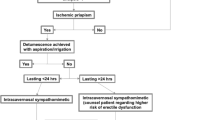Abstract
Penile prosthesis implantation is a surgical option for erectile dysfunction when other treatments fail or the patient prefers implantation. Although penile prosthesis is generally considered safe and effective, various complications have been reported in the literature. High-flow priapism, resulting from an arteriovenous fistula between the cavernosal artery and the corpora cavernosa, is a rare complication after penile prosthesis implantation. Managing the condition as autoinflation may lead to unfortunate complications. A 54-year-old male patient underwent a penile prosthesis implantation due to erectile dysfunction lasting for 5 years. Doppler ultrasound revealed arterial insufficiency that was refractory to oral and intracavernosal treatments. A 3-piece inflatable penile prosthesis (Coloplast – Titan) was implanted through a midline penoscrotal incision without any complications. The patient reported uncontrolled tumescence after activating the device, which led us to suspect autoinflation. The final diagnosis was high-flow priapism due to an arteriovenous fistula in the cavernosal artery. The patient was given an antiandrogenic medication and the prosthesis was deflated for 3 months. The fistula closed without any additional intervention. High-flow priapism is a rare but potential complication of penile prosthesis implantation. Careful evaluation and management of patients’ symptoms are necessary for diagnosing and treating this condition. This case highlights the importance of considering high-flow priapism as a potential cause of uncontrolled tumescence after penile prosthesis implantation and the possibility of successful non-surgical management.
This is a preview of subscription content, access via your institution
Access options
Subscribe to this journal
Receive 8 print issues and online access
$259.00 per year
only $32.38 per issue
Buy this article
- Purchase on Springer Link
- Instant access to full article PDF
Prices may be subject to local taxes which are calculated during checkout


Similar content being viewed by others
Data availability
The data generated during and/or analyzed during the current study are available from the corresponding author upon reasonable request.
References
Salonia A, Bettocchi C, Capogrosso P, Carvalho J, Corona G, Hatzichristodoulou G, et al. European Association of Urology Guidelines on sexual and reproductive health. Presented at the EAU Annual Congress Milan. Arnhem, The Netherlands: EAU Guidelines Office; 2023. ISBN 978-94-92671-19-6.
Van Huele A, Mennes J, Chung E, Van Renterghem K. Majority of erectile dysfunction patients would have preferred earlier implantation of their penile prosthesis: validation of the recently changed EAU guidelines. Int J Impot Res. 2022. https://doi.org/10.1038/s41443-022-00620-1. Online ahead of print.
Kucuk EV, Tahra A, Bindayi A, Onol FF. Erectile dysfunction patients are more satisfied with penile prosthesis implantation compared with tadalafil and intracavernosal injection treatments. Andrology. 2016;4:952–6.
Çayan S, Aşcı R, Efesoy O, Bolat MS, Akbay E, Yaman Ö. Comparison of long-term results and couples’ satisfaction with penile implant types and brands: lessons learned from 883 patients with erectile dysfunction who underwent penile prosthesis implantation. J Sex Med. 2019;16:1092–9.
Wilson SK, Henry GD, Delk JR, Cleves MA. The mentor Alpha 1 penile prosthesis with reservoir lock-out valve: effective prevention of auto-inflation with improved capability for ectopic reservoir placement. J Urol. 2002;168:1475–8.
Di Pierro GB, Lemma A, Di Lascio G, El Motassime A, Grande P, Di Giulio I, et al. Primary versus revision implant for inflatable penile prosthesis: a propensity score-matched comparison. Andrologia. 2021;53:e14240.
Lee WG, Satchi M, Skrodzka M, Papavasileiou G, Ralph D. A rare cause of autoinflation after penile prosthesis insertion: case series and systematic review. J Sex Med. 2022;19:879–86.
Natali A, Olianas R, Fisch M. Penile implantation in Europe: successes and complications with 253 implants in Italy and Germany. J Sex Med. 2008;5:1503–12.
Zaazaa A, Mostafa T. Spontaneous penile tumescence by sparing cavernous tissue in the course of malleable penile prosthesis implantation. J Sex Med. 2019;16:474–8.
Zaazaa A, Bayerle-Eder M, Elnabarawy R, Elbitar M, Mostafa T. Penile hemodynamic response to phosphodiesterase type V inhibitors after cavernosal sparing inflatable penile prosthesis implantation: a prospective randomized open-blinded end-point (PROBE) study. Adv Urol. 2021;2021:5548494.
Mwamukonda KB, Chi T, Shindel AW, Lue TF. Androgen blockade for the treatment of high-flow priapism. J Sex Med. 2010;7:2532–7.
Author information
Authors and Affiliations
Contributions
CB and AK conceived and design the study; CB and EGK performed literature search and created draft; AK and AO revised and finalized draft; all authors have read and approved final manuscript.
Corresponding author
Ethics declarations
Competing interests
The authors declare no competing interests.
Ethical approval
According to our institutional regulations, a single case report with no patient’s identifying information, neither a formal ethical approval nor the participants’ consent is required. All procedures performed in study involving human participants were in accordance with the ethical standards of the institutional and national research committee and with the 1964 Helsinki declaration and its later amendments or comparable ethical standards.
Additional information
Publisher’s note Springer Nature remains neutral with regard to jurisdictional claims in published maps and institutional affiliations.
Supplementary information
Rights and permissions
Springer Nature or its licensor (e.g. a society or other partner) holds exclusive rights to this article under a publishing agreement with the author(s) or other rightsholder(s); author self-archiving of the accepted manuscript version of this article is solely governed by the terms of such publishing agreement and applicable law.
About this article
Cite this article
Baran, C., Kutluturk, E.G., Otunctemur, A. et al. High flow priapism following the insertion of an inflatable penile prosthesis mimicking autoinflation: a case report. Int J Impot Res 36, 3–5 (2024). https://doi.org/10.1038/s41443-023-00776-4
Received:
Revised:
Accepted:
Published:
Issue Date:
DOI: https://doi.org/10.1038/s41443-023-00776-4
This article is cited by
-
Alprostadil
Reactions Weekly (2024)



